2018 Santa Cruz Nomad Carbon CC XX1 Reserve
(discontinued)
| Where To Buy | |||
|---|---|---|---|
Free shipping on orders over $50 (continental U.S. only).
International shipping available. Some exclusions apply. |
|||
Free shipping on orders over $50 (continental U.S. only).
International shipping available. Some exclusions apply. |
|||

Defining the new Nomad left me scratching my head for words. Most everything I wrote sounded like a cliché directly from the 2009 Handbook for Mountain Bike Journalists. "A trail bike that descends like a downhill bike." "A mini-DH bike that can pedal." Yeah, they've both been used ad-nauseam... The ultimate irony to my cliché-laden articulation strugglefest is that the new Nomad is anything but cliché. At a time when most companies seem to be chasing the perfect mid-travel trail bike or eeking every millisecond out of an enduro race bike, Santa Cruz’s latest Nomad iteration seems to be built less for the race course and more for mountain bikers who seek out the most aggressive descents while still wanting the option to pedal back to the top.
The original Nomad predates the enduro craze, launching clear back in 2005, suggesting the bike has always been less about a category and more about packing the most downhill performance into a pedal-friendly package. The latest variant follows the line-blurring direction of its predecessor with more travel, an updated suspension design, and longer reach. Indeed, the new Nomad appears to be aimed squarely at the most aggressive of riders who have access to some of the rowdiest DH terrain.

Highlights
- Available in Carbon C and CC versions June 15, with aluminum following in Fall 2017
- 27.5-inch wheels
- 170mm (6.7-inches) of front and rear wheel travel
- VPP2 rear suspension with revised tune compared to prior Nomads
- Progressive lower-link shock configuration
- Coil or air shock compatible with Metric sizing
- High and low geometry settings via flip chip in link
- Clearance for 2.6-inch Wide Trail tires
- New radial bearing with spacer pivot system
- Bolt on shuttle guard, downtube protector and shock fender
- Internal cable routing
- Threaded bottom bracket with ISCG tabs
- 180mm post mount rear brake (200mm rotor compatible)
- Boost 12x148mm rear axle spacing
- Lifetime frame and bearing warranty
- Santa Cruz Reserve 30 carbon wheel upgrade option
- Sizes: XS, S, M, L, XL
- Colors: Tan & Black, Ink
- Weight: XX1 Reserve build, size large with air shock: 29.3-pounds (13.4kg) // Coil: 30.6-pounds (13.9kg)
On paper, it's hard to fault this bike in any quantitative way. Carbon? Modern geometry? Rising rate suspension design? Coil and air compatible? Ample tire clearance? Laterally stiff? Low center of gravity? Threaded bottom bracket? Metric shock compatible? Long travel dropper post friendly? Full size fun? It checks all the boxes.
Evolution Of The Nomad
The devil is in the details, as the saying goes. Santa Cruz spent a number of years fretting over the small stuff when laying out the new steed and it shows. This is not a half-baked revision of a prior bike, using a cobbling of old and new parts, but something so entirely new we are halfway surprised Santa Cruz stuck with the Nomad model name.
Let's start by taking a hard look at frame hardware. Gone is the company’s angular contact bearing with adjustable preload system. In its place is a more traditional, less torque-sensitive radial bearing with a spacer system. Grease ports still exist for easy maintenance. Overall, the company found this style of interface to be more user friendly and less prone to creaking compared to the previous pivot hardware.

On higher end models, the lower shock mount now features a cartridge bearing as opposed to a DU bushing. The VPP2 design often features more rotation at this point than other designs, making for accelerated bushing wear and unwanted friction when utilizing the more common DU bushings of the past. The bearing interface is stiction free and less prone to wear.
Aesthetically, the suspension layout is a radical departure from the prior Nomad and more closely resembles that of the Santa Cruz V10 downhill bike. Among other benefits, the new design lowers the bike's center of gravity, which is a welcome change when it comes to both cornering and bike stability.




Santa Cruz left no stone unturned, with even the "more minor" things well tended to. The bike’s cable routing is of the internal variety with very clean rubber grommets to dampen any noise. The downtube protector is a bonus for little rocks and tailgates this bike is sure to get hung from at one point or another. Finally, Santa Cruz even integrated a little fender for the rear shock to keep the shock clean and clear of trail debris.
Geometry Changes


The bike now features reach measurements that are 30mm longer than previous Nomads in every size, putting it more in line with industry norms for a respective size. To compliment this longer reach, the seat tube was steepened ever so slightly to put the rider’s weight in a more desirable location when ascending.
Thanks to a new "flip chip" system the head angle and bottom bracket height are now adjustable. In the high position, the head angle matches that of the previous Nomad at 65-degrees with the bottom bracket a hair higher at 344mm. In the bike’s low setting things slacken out to 64.6-degrees and drop another 5mm. Modern dropper posts were taken into consideration with respect to seat tube length, and most sizes see a substantial drop in seat tube length. This gives riders more flexibility to take advantage of longer travel drop dropper posts.
Build Kits & Pricing
Santa Cruz will be offering the bike in a number of builds and frame materials, including an aluminum version later down the line. Pricing for completes in the carbon variety starts at $4,499 and goes to $9,399 (tested).
We were lucky to test the top notch Carbon CC XX1 Reserve variant of the new Nomad priced a hair below $10k. We know this is going to ruffle some feathers. Any bike that approaches this price point had better be good. Worth noting, the lower end builds are still very trail worthy. We wouldn’t hesitate to throw a leg over any of them.


Santa Cruz is offering the bike with both the coil or air variant of the metric RockShox Super Deluxe RCT. Either shock comes standard with a three-position compression adjust lever as well as an all-new independent low-speed compression adjust dial. When considering the bike’s new leverage ratio curve, the bike is well suited to either style of damper. Air shocks tend to be more tunable, and the coil will be the most consistent and supportive in the middle of the bike’s travel.
Looking at component choice, there wasn’t much left to be desired. SRAM's Eagle drivetrain, the new and impressive Code stoppers mated to 180mm rotors, a 170mm travel RockShox Lyrik RCT3, Reverb dropper with new 1X lever, 2.5-inch Maxxis Minion tires, and 170mm cranks. Perhaps most interestingly, Santa Cruz is offering new carbon fiber Reserve wheels. These too left little to be desired, right down to the 30mm internal width and lifetime rim warranty.

Only two points of change within the build, both admittedly incredibly nitpicky. First, at 800mm we found the stock bar a bit too wide as my smashed pinky finger can attest. A quick trim with a hacksaw and this problem was easily fixed. Second, as good as the Codes are, we’d still like to see 200mm rotors. When considering the bike’s intended use it makes sense, at least in the larger sizes.
Ladies Too – Introducing The Juliana Strega
Not one to be outdone, Santa Cruz sister brand, Juliana, also launched the Strega – a women's variant of the Nomad. It's the same frame with a different paint job, narrower bar, softer compression/rebound tune for lighter riders, and wider saddle. The bike's low standover and availability in sizes down to XS will suit a wide range a riders. Fun fact: Strega is Italian for "witch," and the bike comes in a "Wicked" color.





Suspension Analysis
Perhaps the largest change to the new Nomad is the suspension has been completely revised. It features an entirely new leverage ratio curve to better complement the latest slew of air and coil shocks, as well as offering higher performance to the most aggressive riders. Below is a summary of our analysis thanks to André Santos.




Observations:
- The 2018 Nomad has a progressive leverage ratio with a total frame progressivity around 37%. It lacks the characteristic initial "regressive" leverage found on previous editions, thus the initial travel will be slightly smoother and it will have more mid-travel support.
- Will function well with either an air or coil shock. Santa Cruz ships the bike with zero volume spacers in the air shock as testament to the progressive nature of the frame.
- Great pedaling efficiency with 100-120% anti-squat values on most rear cogs for a 32-tooth chainring. On smaller cogs the anti-squat can rise up to 150%.
- The amount of chain growth and pedal kickback are within normal values considering that the bike has a good pedaling efficiency.
- Anti-rise of 80%, meaning that the geometry is quite unaffected under rear braking.
- Overall, the new Nomad is a progressive enduro bike with good pedaling efficiency.
On The Trail
We tested the bike on a number of trails in the Sospel and Triora area of France and Italy over the course of three days. Total vertical was somewhere in the neighborhood of 30,000-feet. Hardly a full blown test, but enough to give us a solid understanding of the bike in both air and coil forms.



The majority of the trails in the area predate the mountain bike by a good 100 to 1,000 years. For those in the lower 48 who haven’t ridden in the area, let me just say "it's different." Different how? Well, the majority of the trails were not built with a bicycle in mind, but were instead built for some other purpose like the military, a trade route, etc. This often meant they were steeper and tighter than what you might find in the States. It also serves as a good reminder as to why so many incredible riders come out of this particular region.
Ascending
Most of our riding was via shuttle with only about 1,000-feet of climbing in the entirety of the three days. As such, I’m not going to pretend I can give a full review on the bike’s uphill ability as I wasn’t given ample opportunity to really test the bike’s characteristics while going against gravity. That said, based on the limited time I spent climbing aboard the new Nomad, it seemed to perform at an acceptable level for a bike with a 65-degree headtube, low bottom bracket, and 170mm of travel. With good anti-squat properties and SRAM Eagle’s large gear range, most any ascent should be conquerable. Just don’t plan to win any uphill Strava KOMs along the way. Using the shock’s compression adjust lever along with putting the Lyrik fork in one of its firmer modes helps on smoother ascents where out of saddle efforts are required.
With good anti-squat properties and SRAM Eagle’s large gear range, most any ascent should be conquerable. Just don’t plan to win any uphill Strava KOMs along the way.
Turning to frame geometry for ascending, especially compared the the prior Nomad, the most obvious thing I noted was how much more forward I felt over the crankset despite the longer reach. Though the company only modestly steepened the seat tube, it certainly had an effect on rider position while climbing. The more rider-forward position is immediately noticeable on the pedals.
Weight is in line with the previous Nomads with sub 30-pound builds attainable. Would I take it on an all-day epic? Sure, with the right tires and a bit of suspension fiddling. But again, for real commentary on the bike’s overall versatility, especially in the ascending category, I’d need more time pointing the bike uphill.

Descending
Now for the goods – what this bike was designed to do. With 170mm of travel, the Nomad isn’t going to give you the sports-car feel a shorter travel bike might. Simply sitting on the bike, with a hair over 50mm of sag, the rider is left with a feeling of being "in" the bike as opposed to "on top of" the bike.
Once pointed downhill, the first attribute that struck me is just how forgiving the new Nomad is. Considering the jet lag and copious amounts of wine from the night before, this was a very welcome feature. Errors that would have put me on the ground with most any other pedal-worthy bike (including the prior generation Nomad) left the new bike completely unfazed.
The bike begs you to ride it in an aggressive position, equally weighting the front and rear wheel, lowering your head and consciously "pushing" or "loving" the front wheel, especially in less-than-steep terrain.
The second thing that struck me about the bike was just how much traction I had in less than ideal trail conditions. This was particularly evident when cornering as I often found myself with more grip than balls. The combination of a low center of gravity, tried and true 2.5-inch Maxxis DHF tires, a well-tuned suspension design, stout lateral stiffness, high performing wheels, and balanced geometry all contributed to this. Worth noting, I did find myself riding off the back of the bike more than I should have been. This was a me problem not a Nomad problem. The bike begs you to ride it in an aggressive position, equally weighting the front and rear wheel, lowering your head and consciously "pushing" or "loving" the front wheel, especially in less-than-steep terrain. Otherwise, it can be easy to feel as though the front end wants to push and doesn’t have the grip it otherwise should (and does).


Due to the progressive nature of the bike, the Nomad is easy to put in the air and double trail features. Now, this may sound confusing as I previously noted the bike is more monster truck and less sports car. Overall, it's not going to respond to rider input as quickly as a shorter travel bike might, but that doesn’t mean the bike falls through its travel when the rider goes to load the suspension. Hence, it may take a hair longer to load than a well designed bike with less travel. The bike is still very playful, though, encouraging you to eye up any gap you deem possible.
In higher speed rough terrain the bike was extremely quiet and stable. The suspension did its job admirably, with the best adjective I can come up with being "fluttery." I found myself needing to look further ahead, stay in the middle of the bike, and worry more about the general direction of the trail as opposed to fretting over every nuance as I might on a smaller bike. Think more "Rambo," less "ninja."
The riding was rife with tight switchbacks. So much so I found myself in a crash course (pun intended) into nose wheelie style euro turns. In tighter, steeper, more technical terrain I sometimes felt as though the bike was a bit cumbersome, at least in the XL variant. After a few rider-position adjustments I found the bike manageable in these situations, though I never felt particularly quick. To be honest, tight and steep switchbacks have never been my bag, all the way back to my downhill racing days. Again, I’d pin this on me more than the bike.
In technical, steeper, less tight terrain where I wasn't ducking out of the way of trees, medieval walls, or navigating über tight switchbacks, the bike was an absolute beast. Lower your head, drop your heels, stay off the brakes and WOW. The slack headtube, long reach, wide bars, confidence inspiring tires, and superb damper performance all worked in symphony giving near downhill bike performance.
Lower your head, drop your heels, stay off the brakes and WOW. The slack headtube, long reach, wide bars, confidence inspiring tires, and superb damper performance all worked in symphony giving near downhill bike performance.
At times, the air shock seemed to ride lower in the travel than I’d like, but our testing time was limited. The coil was a hair less forgiving but offered more support. As my confidence in both the trails and the bike grew, so did my preference for the coil shock, specifically in high-speed corners. The bike remained a hair more level and had more available travel. Again, take these findings with a grain of salt as tuning time was extremely limited. If I had to bet, I’d wager I could get the air or coil shock to perform very similarly with some fiddling. In our experience, most riders would be better off with an air shock simply because its more tunable for less money (shock pump vs swapping springs). That said, if you are really getting after it, coil is worth the look as well.
When I blew a line or corner and needed to come back up to speed, I could tell I had 170mm of travel, but it didn’t feel like I was in molasses. Those who chose to race this bike may swap for a bar-mounted lockout, though they’d lose the independent compression adjust dial.

Compared To The Nomad Of Old
Many will ask for a comparison of this bike to the old bike. In a sentence, they are completely different. Yes, the head angle, bottom bracket height, and chainstay length is all similar. If one were to look at specs alone, the only two things that separate the two bikes is 5mm more travel and 30mm more reach. However, to boil the differences down to those two numbers would be a tragic analysis error. The suspension tune alone leaves the rider feeling as though the new bike has far more than 5mm more travel than the prior generation bike. To add, the bike responds to rider input in a more effective and efficient manner, the geometry puts the rider in a totally different place on the bike, and the center of gravity is much lower. These changes, in combination with everything else, make for an entirely different feeling ride than any Nomad of the past.
The bike responds to rider input in a more effective and efficient manner, the geometry puts the rider in a totally different place on the bike, and the center of gravity is much lower. These changes, in combination with everything else, make for an entirely different feeling ride than any Nomad of the past.
Versatility
As I indicated above, I didn’t pedal it as much as I would have liked, but my hunch is it’ll motor up a trail just fine so long as expectations are kept in check. So then, why not make this steed your do-everything trail bike? Well, you could. It’d likely be fine, but it’d also create an overly muted, boring, trail experience if you found yourself riding smooth and flowy singletrack often. In a way, it's like fishing with dynamite on your local trails. It's overkill. Things might get messy.

Again, if you can only have one bike, often find yourself on rowdy descents, live near a world class bike park, and still need to pedal your local XC loop, maybe this is your bike. Maybe. That all depends on what you prioritize. For me? I will be frank and say I don’t live in an area with enough gnarliness to press this bike day in, day out. For me it’d be a bike to throw in the truck when I’m going to Whistler, put on an airplane for the alps, toss a dual crown on and race the occasional downhill race, or ride when I go tackle the handful of trails in my area worthy of a bike this capable.
As an enduro race bike, I could see it having merit in Europe where tracks are often gnarlier than the US, especially for an aspiring amateur. There is a certain "cloak of invincibility" the bike gives you, which in this case can be the difference between staying upright and not. That said, I wouldn’t rule it out for the Santa Cruz Enduro World Series racers, track depending.
Finally, with respect to the gravity-only application, expect to see the Nomad and Strega as niche downhill race bikes for a number of smaller, lighter, or more finesse-oriented riders. Being it's made in a full size run (including an XS) and can be run with a dual crown fork (though SC mentions the rider needs to be extra cautious about fork bumpers), we could very well see this as the weapon of choice for a lighter weight rider or the luckiest 12-year-old alive.

What's The Bottom Line?
The all-new Santa Cruz Nomad is a unique bike that left me deep in thought when trying to figure out where it fits in or what it's capable of. Now in its fourth generation, it's the first bike in a long time that seemed to really check my ego (I wasn’t good enough to ride this bike anywhere close to its full ability), and maybe that’s the beauty to the bike. It's nomadic in that you can take it just about anywhere in the world and never say "I’d ride that if I was on a more capable bike." Though it may be a bit much for your local trail ride, it very well may leave you parking the downhill bike at even the gnarliest of bike parks. Yes, it appears the new Nomad can do it all, even if it's not a purpose-built enduro weapon, a full-on downhill bike, or a mild-mannered trail steed.
If you live in a place that has rowdy trails, have a propensity to look for the gnarliest stuff around, and can only have one bike, take a hard look at the Nomad. After all, the lens of "versatility" highly depends on perspective. This is the new standard for the true gravity addict who still wants the ability to pedal to the top. There may be little out there like it, but Santa Cruz isn’t a company that was founded on following the masses...
Visit www.santacruzbicycles.com for more details.
Vital MTB First Ride Rating
Climbing: 3 stars - Good
Descending: 5 stars - Spectacular
Fun Factor: 5 stars - Spectacular
Value: 3 stars - Good
Overall Impression: 4.5 stars - Outstanding
About The Reviewer
Jeff Brines - Age: 32 // Years Riding MTB: 18 // Height: 6'2" (1.88m) // Weight: 200-pounds (90.7kg)
Jeff didn't go on a real date until he was nearly 20 years old, largely as a result of his borderline unhealthy obsession with bicycles. Although his infatuation with two wheels may have lead to stuttering and sweatiness around the opposite sex, it did provide for an ideal environment to quickly progress through the ranks of both gravity and cross-country racing. These days, Jeff races enduro at the pro level, rides upward of 150 days a year while logging over 325k of human powered ascending/descending on his bike. Bred as a racer, Jeff is more likely to look for the fastest way through a section as opposed to the most playful. He lives in the shadow of the Tetons in Jackson, Wyoming.
Photos by Gary Perkin, Sven Martin, and Jeff Brines
Specifications
Rear: Industry Nine Torch Classic, 12x148mm, 28 hole, XD
Rear: Maxxis Minion DHR II EXO TR, 27.5" x 2.4”
Progressive lower-link shock configuration
Metric shock sizing
Bolt-on shuttle guard, downtube protector and shock fender
Air and coil shock compatibility
180mm post mount brake
| Where To Buy | |||
|---|---|---|---|
Free shipping on orders over $50 (continental U.S. only).
International shipping available. Some exclusions apply. |
|||
Free shipping on orders over $50 (continental U.S. only).
International shipping available. Some exclusions apply. |
|||










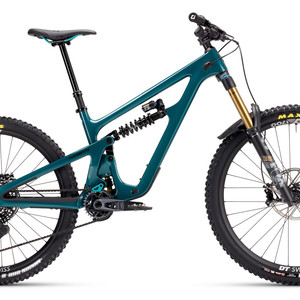
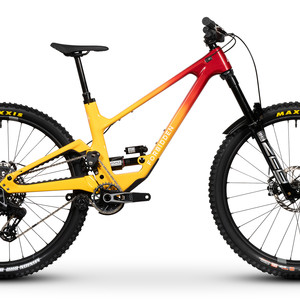
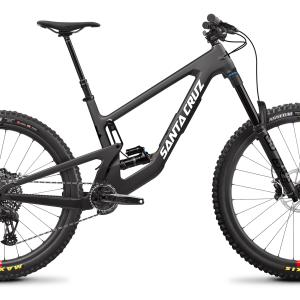
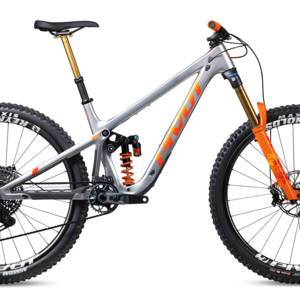

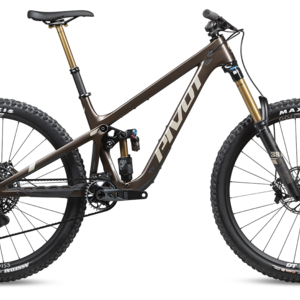

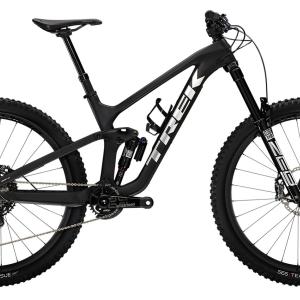
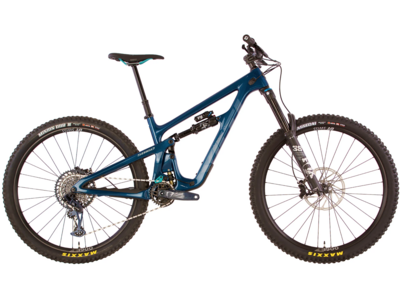






30 comments
Post a reply to: First Look, First Ride: The All-New 2018 Santa Cruz Nomad